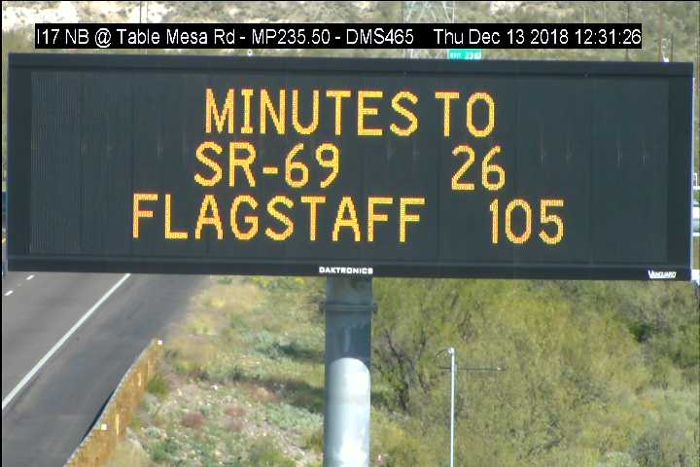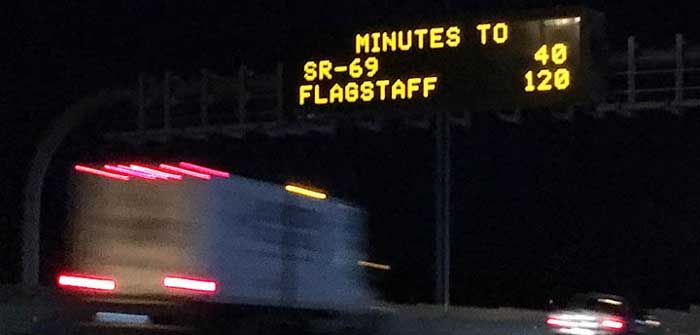The Arizona Department of Transportation (ADOT) has added journey-time information to its electronic message boards that are deployed along the Interstate 17 corridor in a program that is the agency’s first for a state highway outside the Phoenix metropolitan area.
As it already does along the Phoenix-area freeway network, ADOT has started posting estimated travel times via I-17 to Cordes Junction, Prescott, Sedona, Flagstaff and other points north of the Phoenix metropolitan area, often referred to as the Salt River Valley or Valley of the Sun.
The new display of I-17 travel times is a first for a rural section of the state’s highway system. For a decade, ADOT’s message boards have provided travel times to Valley-area drivers, which have proved to be a popular feature with commuters, as they can alert drivers to congestion or slow-moving traffic ahead, giving them the option of finding an alternative route.
The I-17 is one of Arizona’s Key Commerce Corridors, serving as the primary route for moving people, goods and services between the Phoenix area and northern Arizona communities.
As examples of the types of information conveyed by its new journey time system, ADOT cited a recent morning, with no weather-related delays or backups due to traffic incidents, where a message board north of Jomax Road estimated 120 minutes to travel 125 miles (193km) to Flagstaff and 40 minutes to travel 43 miles (70km) to the State Route 69 interchange in Cordes Junction, indicating an average speed of 62mph (100km/h) would be possible for drivers.
 ADOT says a message board such as the one on northbound I-17 near Sunset Point Rest Area can tell those heading to Sedona whether State Route 260 or State Route 179 is the most efficient route. Southbound I-17 message boards can tell drivers whether State Route 169 or State Route 69 is the better option to Prescott.
ADOT says a message board such as the one on northbound I-17 near Sunset Point Rest Area can tell those heading to Sedona whether State Route 260 or State Route 179 is the most efficient route. Southbound I-17 message boards can tell drivers whether State Route 169 or State Route 69 is the better option to Prescott.
While travel times posted in the Valley region come from ADOT’s in-pavement traffic-flow sensors, the new I-17 travel times draw on real-time traffic data supplied by the mobility analytics company Inrix, which helps transportation agencies monitor, measure and manage traffic information from its suite transport management services. ADOT has designed a software application to automatically process the ‘crowdsourced’ Inrix data for I-17, something that the agency says it can eventually roll out across other busy routes.
“One reason we’re expanding along I-17 is that winter weather can affect travel times to or from key destinations in northern Arizona,” said Brent Cain, who leads ADOT’s Transportation Systems Management and Operations division. “Estimated times that reflect highway conditions can assist drivers with their travel plans. Using data from the marketplace allows us to expand our ability to support informed and safe travel around the state.”






